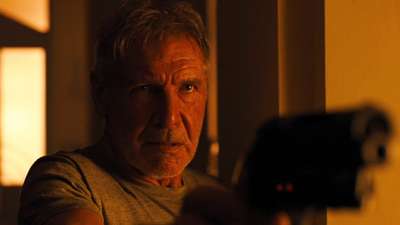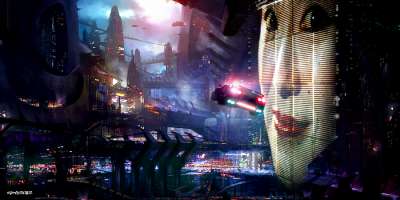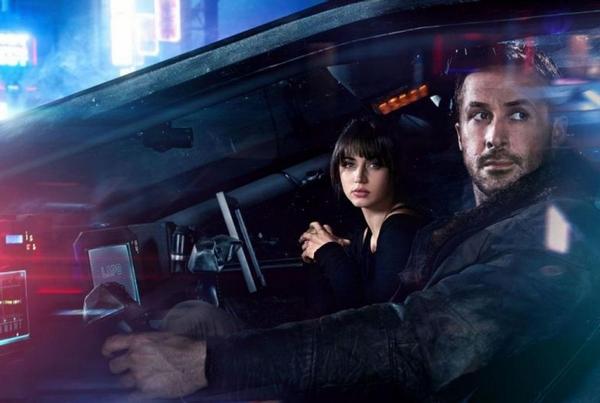“Blade Runner – 2049” – a film review by Gary Chew
The year is 2049, not 2017. Things are even worse than in the current hurt of Trump World. It’s still raining dirty drops on Los Angeles. The flying automobiles, swishing and wriggling through the grimy mist, still seem about to crash into faceless skyscrapers. But the operator of one of those sleek, edgy aero/autos is Ryan Gosling (Call him Officer “K” or Joe), so it’s not all bad in this cinematic extension of the fantastic imagination housed … once upon a time … in the brain of author Philip K. Dick.
 First, I need to say that the adroit director of this shiny, new Blade Runner, Denis Villeneuve, sent a written appeal to the few film commentators gathered and breathlessly awaiting the picture to play on a huuuge Sacramento screen. (The only things “larger” than it, we all realized, as the film began, were the speakers hidden away in this up-to-date movie theater; no earplugs were provided.) Villenueve courteously asked us to not give out any spoilers in our copy, and that some characters seen in his film go unmentioned. The director’s plea was read to us by Terry, the gentleman running the screening for Warner Bros. In 2016, Monsieur Villenueve gave us Arrival, the spine-tingling sci-fier known for totally screwing over one’s head with an entity that simultaneously exists in the past, present and future. Yip, trippy, and so the new Blade!
First, I need to say that the adroit director of this shiny, new Blade Runner, Denis Villeneuve, sent a written appeal to the few film commentators gathered and breathlessly awaiting the picture to play on a huuuge Sacramento screen. (The only things “larger” than it, we all realized, as the film began, were the speakers hidden away in this up-to-date movie theater; no earplugs were provided.) Villenueve courteously asked us to not give out any spoilers in our copy, and that some characters seen in his film go unmentioned. The director’s plea was read to us by Terry, the gentleman running the screening for Warner Bros. In 2016, Monsieur Villenueve gave us Arrival, the spine-tingling sci-fier known for totally screwing over one’s head with an entity that simultaneously exists in the past, present and future. Yip, trippy, and so the new Blade!
Time, however, is not so much the essence of Blade Runner – 2049. As is the first take of this Dickian tale about a dark Southern Californian future, so does the new one lay on large amounts of dystopian dread. By the way, on my second viewing of this new film … a couple of days later … most of the coming attractions preceding the main event were also touting violence and danger in the days ahead for this human race of ours. That made me wonder that if Hollywood makes a plenitude of this genre, moviegoers might simply “give up” by being inured to Orwell’s weighty homily of 1984. Let us hope not.
 Joe or Officer “K” (Gosling) is a nice … well maybe a not so nice LAPD robotish/human cop much like his predecessor we all knew and loved in Blade Runner The First : Rick Dekard (Harrison Ford). Gosling is just right for this new character. And no one else could ever be Dekard but this Ford fellow.
Joe or Officer “K” (Gosling) is a nice … well maybe a not so nice LAPD robotish/human cop much like his predecessor we all knew and loved in Blade Runner The First : Rick Dekard (Harrison Ford). Gosling is just right for this new character. And no one else could ever be Dekard but this Ford fellow.
Three decades after Blade One, Office “K” discovers something buried under a dead tree that could heave this 2049 society into even more profound chaos. Officer “K,” being cruelly ordered to carry out the mission by Lieutenant Joshi … a really butchy Robin Wright wearing black … must find what the buried secret suggests. (I feel restrained from saying just what Joe or Officer “K” is seeking due to Monsieur Villenueve’s expressed fear of any hint that might spoil his creation.)
I hope it’s okay for me to spoil out to you that Dekard finally shows up in the third act, appearing in a most Kubrikian-like scene that brings together, for the first time, Dekard and Officer “K” or, by now, just called Joe. The scene is set in a lofty, glassed-in penthouse on a slender skyscraper that looks down on a forlorn Las Vegas. The weather hasn’t improved a damned bit. The fight scene between these two heroes, one old, the other young, takes waaaay tooooo long, just like the entire movie. To put a point on it: the numerous fight scenes are what make Villenueve’s film in dire need of an intermission, especially for elderly males.
Eye candy is neither in short supply. There’s the lovely Ana de Armas as a holograhic beauty called Joi. Joe can bring her to life by merely pressing a button and hearing the opening strains of a familiar piece of music by Sergei Prokofiev, a favorite Russian composer of mine. In competition with Joi is another striking beauty called Mariette, played by MacKenzie Davis. Ms Davis will resonate with you to recall the character Daryl Hannah played in the first Blade. How can any of us forget Pris and those inviting flip-flops she does just before Dekard wastes her way back in 2019. Happily, Mariette is a nice girl, and all human, but her haircut and its coloration do make one remember the obstreperous Pris.
 Another new female character is introduced in 2049. Her name is ironically inappropriate: Luv. Oh, but Luv in a really bad girl; and like Pris, very, very strong. Hmm, yes Luv isn’t really human, even though she seems to be. Her tussles with Officer “K” are as rigorous and dynamic as the one Deckard has with Pris … but much, much greater in duration. Did I mention that Blade Runner – 2049 runs 2 hours and 44 minutes, not counting the credits which drag on for 14 more minutes?
Another new female character is introduced in 2049. Her name is ironically inappropriate: Luv. Oh, but Luv in a really bad girl; and like Pris, very, very strong. Hmm, yes Luv isn’t really human, even though she seems to be. Her tussles with Officer “K” are as rigorous and dynamic as the one Deckard has with Pris … but much, much greater in duration. Did I mention that Blade Runner – 2049 runs 2 hours and 44 minutes, not counting the credits which drag on for 14 more minutes?
Monsieur Villenueve has added another role to his long list. This character has the ridiculous name of Niander Wallace. That would feature Jared Leto’s excellent portrayal. I can’t be precise in saying what it is that Niander is in the film, but he’s really important and powerful; maybe a bit like the guy Frank Morgan played in The Wizard of Oz. Unfortunately, Niander, in his quiet, creepy demeanor, could be categorized as a Messianic meanie. Leto’s makeup includes weird eyes that seem to be those of a blind man who … yet … sees all!
Blade- 2049 can boast that its substance is: how can one detect what reality is, given all the virtual BS that’s arrived since the turn of century? Along the convoluted way of this motion picture, Lieutenant Joshi barks at Officer “K” something about “always looking out for something real!”
Don’t let me put you off on this stop at “Blade Runner Central.” The film is a visual masterpiece. One scene in particular involves Gosling, Armas and Davis: one man and two women. The special effects for it are mind blowing, and not just because the scene might be suggesting there’s a ménage à trois about to congeal … though and alas, not depicted.
Rated R for ladies sometimes saying the f-word.

- Movie Review: ‘The Glorias’ - September 28, 2020
- Movie Review: ‘I’m Thinking of Ending Things’ - September 10, 2020
- Movie Review: ‘The Burnt Orange Heresy’ - August 31, 2020


